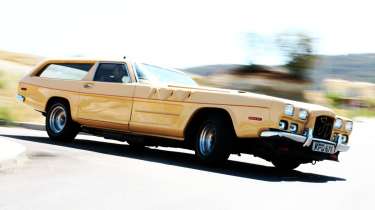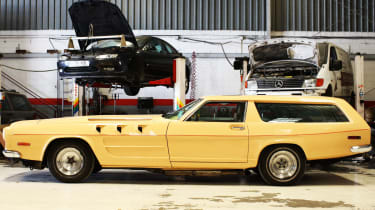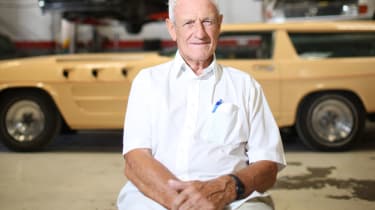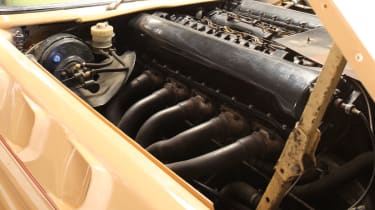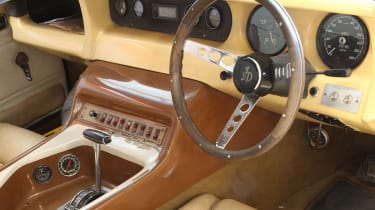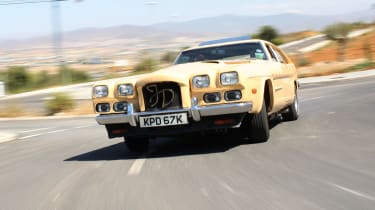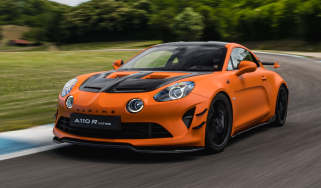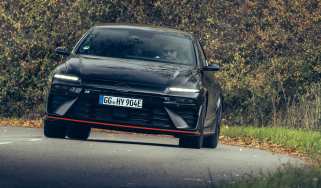Driving The Beast – 27-litre Merlin V12-powered GT tested
Ollie Marriage tracks down the 27-litre Merlin-engined monster that was once the most powerful road car in the world
I switch her off going downhill. That way I get 5 to 6mpg rather than 2. Don’t make no difference to the way she drives – got no power steering, y’see.’ He’s yelling. He has to to be heard over the phenomenal clanking that renders the engine inaudible. That’s quite something when the motor in question is a Merlin. ‘That’s the step-up gearbox. It’ll get quieter once we pick up speed,’ he shouts. Boy do I hope so.
I’m a fraction uneasy. My chauffeur is 75 if he’s a day, it’s 34 degrees outside – double that in here – and he’s trying to negotiate a small traffic island in a 40-year-old car that’s longer than a Maybach, has an engine weighing the best part of a ton and no steering assistance. Oh, and a distinct whiff of petrol is mingling with a burnt rubber odour. Not tyres, but the soles of my shoes…
Norris McWhirter has a lot to answer for. Back in my short-trouser, scabbed-knees days I was obsessed by facts and stats, unbeatable at Top Trumps and never far from a well-thumbed Guinness Book of Records – my bible. Favourite section? ‘The Mechanical World’, of course. Favourite record? Most powerful road car. Can’t say why exactly. Maybe even then, despite an over-fertile imagination, I couldn’t conceive of someone popping a 27-litre V12 WWII aero engine in a road car and making it work. What a sublimely, extravagantly daft thing to do.
So daft that, as the years passed, I began to doubt The Beast (for that was its name) had even existed. So I decided to try and track it down. To be honest I thought this was a search that would end at a scrapheap. Clearly it didn’t.
Part one was easy. Switch on computer, point browser at Google and soon enough you’ll find yourself sifting through Wikipedia articles, forums, even an old Top Gear clip on YouTube (maniacal presentation by Steve Berry). A day’s research was best summed up as too much information, all of it conflicting.
But compelling, too. The more I read, the more I got sucked in, even though everything was couched in the same phraseology: ‘some say’, ‘rumour has it’, ‘according to legend’. Apparently the engine was from a tank/was from a Spitfire/wasn’t a Merlin at all, allegedly it had burnt to cinders/now lived in Spain/was being rebuilt in the UK, and supposedly it had destroyed Porsches on the Autobahn/was capable of 200mph/had touched 260mph.
I pinged off masses of e-mails. There were hints and suggestions of where I might be able to find out more, contacts that came to nothing. And then something. An e-mail address, which later became a phone number, which yielded a foreign mobile and, less than a week later, a handshake in a dusty industrial unit a mile from Malaga airport.
The bloke vigorously pumping my hand is John Dodd, slight, sinewy, tough, proud proprietor of Caja de Cambios Automaticas and owner of the fantastical contraption just to my right. There it is, bold as brass, glaringly beige and dwarfing the Silver Shadow parked behind it: The Beast. It’s just as I remembered. It’s not a looker, but you can’t help gawping. Ten-foot-long boot, ten-foot-long bonnet, and in the middle a pair of futuristic chairs like something out of Buck Rogers. ‘Can’t remember where those came from,’ John tells me, ‘but the doors were cast from a mkIII Cortina’s.’
We have a quick guided tour, but John wants to talk and I’m all ears. Finding the Beast is one thing, but being able to chat at length with the man responsible for its existence is quite another. We start at the beginning. ‘It was Jameson’s idea,’ says John, ‘Paul Jameson. He was a whiz with the Merlin. He built the running chassis and asked me to do the gearbox.’ Ah, the gearbox. Getting 27 litres of Merlin to talk amicably to a Jaguar XJ12 back axle was the key, and Dodd was an automatic gearbox guru – still is. He designed and built a step-up ’box to allow the low-revving Merlin (120rpm at idle) to connect to a GM Turbo 400 three-speed gearbox without thrashing itself to pieces – even though it sounds like it is.
‘Never got round to refining it,’ Dodd shrugs. ‘I’d like to do that one day – and add power steering, too. But at least mine runs properly. Most people with Merlins can’t keep ’em cool. Royce didn’t design them to be put in cars…’
We open up the bonnet (it’s a two-man job). The dark Merlin nestles peacefully, its last two cylinders tucked back under the bulkhead. ‘It was very advanced in its day, this engine. Very,’ says Dodd seriously. ‘This one came from a Boulton Paul Balliol aeroplane. It’s all aluminium, two sparks per cylinder – that’s an aviation rule, of course – and dry sumped. I changed mine to wet, though. Helps with the cooling.’ As does the 10-gallon oil reservoir and a radiator the size of an Aga. No-one’s quite sure how much power the engine produces, but ‘about a thousand brake’ is John’s best guess.
I ask Dodd about the legendary story of a Porsche-driving German baron who phoned up Rolls-Royce to enquire about its new model after the Beast had swept past him on the autobahn. ‘That was me!’ he laughs. ‘Just having a bit of fun. I used to do it quite often actually. Phone up the salesmen in a funny accent, tell them I’d seen this car doing 200mph…’
Was it really that fast? ‘Most I saw was 185. Beyond that it was a bit dicey – there was always a risk of the flywheel coming apart and I once had the tyres disintegrate at 150mph on the way to Pebble Mill. Bloody awful those Firestones. But she’s steady as a rock [at speed], absolutely beautiful.’ There’s a pause. ‘Till you get to a corner, of course. Then she gets a bit tricky…’
It's the next day. Photographer Gus Gregory and I, accompanied by John and his daughter Soosie, spent the previous afternoon scouting the locale for roads that will suit both the Beast and Gus’s Canons. It was an elusive hunt. The Beast is an irascible old girl – doesn’t like traffic, doesn’t like heat, doesn’t like small roads – and has a raging thirst. ‘My rule of thumb is a litre every kilometre,’ John tells me. I do a quick mental calculation and work out that the 26-gallon tank will be parched in about 100 miles. We have five gallons on board. (‘Regular 95 unleaded. Runs fine with no mods. Only BP fuel, mind you.’)
There’s reason to be cheerful, though. It’s a dazzlingly bright September morning, we’re well breakfasted and the Beast is ready to rumble. Quite literally.
I hop into the passenger seat, feet resting on a tangle of jump leads and an industrial-sized fire extinguisher. There’s a line of switches that John’s busy manipulating. ‘First you switch on the ignition, then the fuel pumps, prime the engine, then the starter.’ Nothing happens. ‘Oh, forgot the magnetos.’
There’s a dusty cough. Then another. And another. Finally the V12 catches. For a second you get a hint of Spitfire, but it’s surprisingly docile and breathy due to the properly silenced side-exit exhausts that replace the six straight-through pipes. Then the mellifluous thrum is shouted down by that cataclysmic mechanical melee. It’s less noticeable outside, but inside the gearbox is right next to my right leg. I swear the transmission tunnel is pulsating. So’s my head.
John goes for a gear (‘doesn’t really matter which one’) and there’s a sudden, violent lurch as it engages. The brakes are released and we’re away. Thoughts rush through my head thick and fast. Where does the bonnet end? That van’s very close. Surely this bloke’s not strong enough. Are there some earplugs? I can’t believe I’m here! Was this really a good idea?
Then we drive out of the shed. Up and running on a dual carriageway, the satanic milling subsides and the Merlin finds its voice. It’s not as menacing or loud as I expected, but sonorous, humming. Then, as we accelerate, it becomes a high-pitched wail. It’s hard to believe there’s 27 litres pumping away up front. Then I notice the speed. It’s not that we’re accelerating particularly hard, but it’s the manner with which it’s happening that’s so unusual. There’s barely a movement from the rev counter, yet there’s a silky gain of pace, like standing in a strong wind and leaning back, feeling it support you. It’s wonderful.
And then it’s my turn to drive. John’s nervous; only a handful of other people – three, he reckons – have ever driven the Beast. So, what’s it like? Well, here’s the thing. If you were to design the perfect driver for the Beast he would have Fred Astaire’s feet mated to Giant Haystack’s upper body. That way you could be all dainty with the throttle yet give the steering what for. As a normal human being you find yourself fearfully stroking the accelerator while heaving frantically on the wheel.
That you can manipulate the steering at all comes as a surprise, especially as the Bakelite rim’s on the verge of crumbling to dust. Roundabouts, even quite large ones, require full lock. But as I grow slightly accustomed to it, the realisation dawns. The Beast is actually a pussycat. It doesn’t bite if you prod the throttle, it likes to be driven, and as long as you only need to make small inputs – changing lanes, for instance – it’s easy and light to guide along.
Braking is another matter. Sheer inertia means slowing from high speeds is a brutal business. As for moving off, you know that feeling you get just before take-off when the pilot builds-up power while holding the plane on the brakes? That’s what it’s like when you drop the Beast into gear. Release the middle pedal and she’s off – this transmission doesn’t creep, it shoves.
Handling? Well, imagine a car with the front suspension and steering from a mid-’60s Austin 110 Westminster, the rear axle from a Jaguar XJ12 of the same vintage and, in between, a largely homemade chassis with a 60-year-old engine as a stressed member. Alarming, isn’t it? Yet this is that car. The ride’s reasonable, but sophisticated? No.
And then a coolant hose starts hissing. Game over. We limp home. But apart from that minor glitch I’m amazed how well the Beast has coped with the heat, low-speed driving and the constant stop-starts. All the same, you don’t need me to tell you she’s in need of a bit of TLC – it’s one reason why John’s thinking of selling. Would that I had the space at home…
Gus and I have a flight to catch, but there’s time for one last question: Did you ever use it as your daily driver? ‘Well, I’ve driven it from the UK to Spain and back three times,’ says John, ‘even towed a caravan with it.’ Really? ‘Yep, in the Guinness Book of Records for years. Did 107.5mph at Silverstone.’ My shoulders slump. I had no idea…
evo10 moments
I’m on my way home from Gatwick in my Lexus IS-F long-termer, and despite the lateness of the hour and the wetness of the weather, I’m curiously elated. Just been driving the Beast, y’see.
Anyway, instead of the route of least resistance, the IS-F and I go a touch off piste. Green signs, not blue, point my way home tonight. And we’re bonding; V8 roaring away, jarringly sharp body control, rich vein of personality. In fact, we’re getting along great.
In the background, the night-shift DJ on local radio presses play on Paul Simon. ‘You know the nearer your destination the more you’re slip slidin’ away…’ croons the pint-sized singer as, five miles from home, the roundabouts on the A339 outside Greenham Common heave into view. ‘How apt,’ I think.
There’s three, all of them slippery tonight, and I’m enjoying a good lap of the third one when blue lights stop play. Never have I fought to get rid of opposite lock so fast, as along comes a fully Battenburg’d 5-Series Touring. And there it goes, neatly round to exit three with the tail 30 degrees out of line. Once I’ve collected my jaw from the floor, I drive home at 30mph. – Ollie Marriage
The Beast: specs
| Engine | V12 |
| Location | Front, longitudinal |
| Displacement | 27000cc |
| Bore x stroke | 137.2 x 152.4 |
| Cylinder Block | Aluminium alloy |
| Cylinder Head | Aluminium alloy, sohc, four valves per cylinder |
| Fuel and Ignition | Four-barrel Holley carburetor with automatic mixture control |
| Max Power | c950bhp @ 2500rpm |
| Max Torque | c760lb ft @ n/a rpm |
| Transmission | Three-speed automatic GM Turbo 400 gearbox, rear-wheel drive |
| Front suspension | From Austin A110 Westminster – independent, coil springs, lower wishbones, anti-roll bar |
| Rear suspension | From Jaguar XJ12 – independent, lower wishbone/upper driveshaft link, radius arms, twin coil springs |
| Steering | Worm and roller |
| Brakes | From Jaguar XJ12 – front discs and rear inboard discs |
| Tyres | 235/70 R15 Cooper Lifeliner Classic |
| Weight | 2250kg |
| Power to weight | 429bhp/ton |
| Standing 1/4 mile | 12sec |
| Top speed | 185mph+ |
| evo rating | 5/5 |
